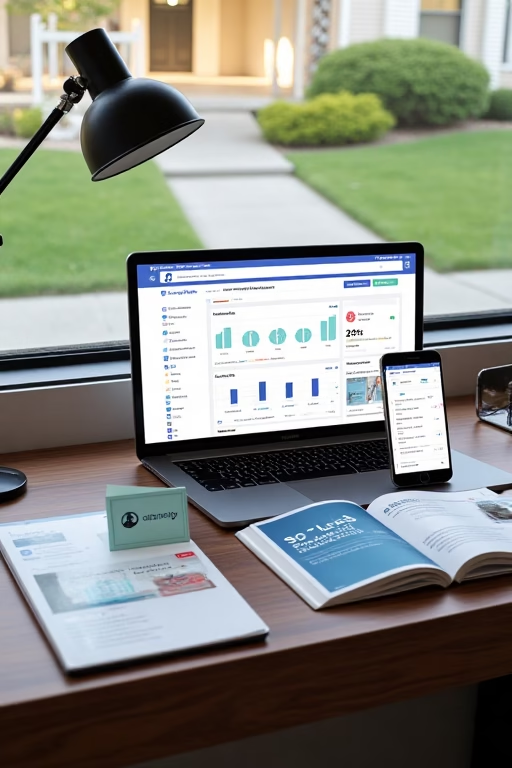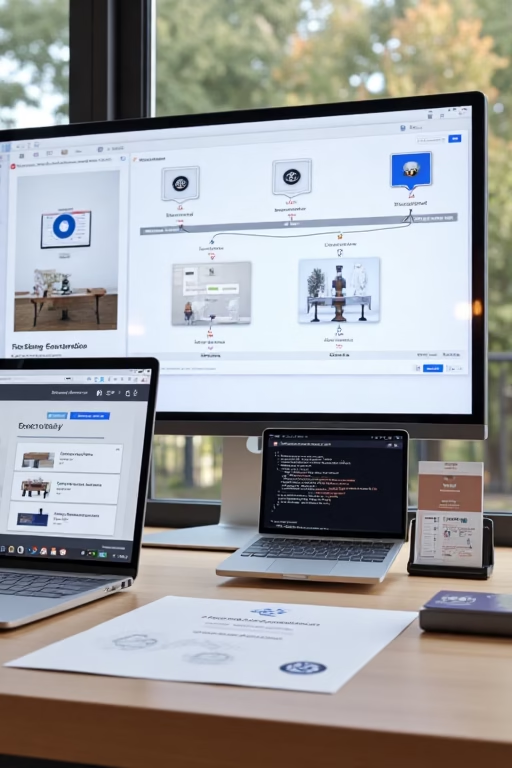Sell More on Facebook Marketplace Without Paying for Ads
Sell More on Facebook Marketplace Without Paying for Ads
Your Organic Growth Blueprint by Market Wiz
Table of Contents
- Introduction: Why Go Organic?
- 1. Optimizing Your Listings
- 1.1 Crafting Clear, Keyword-Rich Titles
- 1.2 Writing Benefit-Driven Descriptions
- 1.3 Professional Photos & Video Clips
- 1.4 Accurate Categories & Tags
- 2. Leveraging Free Facebook Features
- 2.1 Boost via Marketplace Groups
- 2.2 Use Facebook Stories & Reels
- 2.3 Engage with Buyer Comments
- 2.4 Invite Follows to Your Shop
- 3. Building Trust & Engagement
- 3.1 Prompt, Polite Responses
- 3.2 Displaying Reviews & Ratings
- 3.3 Offering Free Inspections or Demos
- 3.4 Maintaining Consistent Stock Updates
- 4. Effective Pricing & Incentives
- 4.1 Competitive Price Research
- 4.2 Bundles & Package Deals
- 4.3 Time-Limited Discounts
- 4.4 Free Shipping or Local Pickup
- 5. Seasonal & Trend-Based Tactics
- 5.1 Holiday & Event-Themed Listings
- 5.2 Matching Local Trends
- 5.3 Flash Sales & Pop-Up Offers
- 6. Monitoring & Continuous Improvement
- Conclusion & Next Steps
- 25 Frequently Asked Questions
- 25 Extra Keywords
Introduction: Why Go Organic?
With rising ad costs and fierce competition, selling on Facebook Marketplace without paying for ads has become an art. By optimizing every element of your listing, engaging buyers organically, and tapping into free platform features, you can consistently attract and convert leads—without spending a dime on advertising.
1. Optimizing Your Listings
1.1 Crafting Clear, Keyword‑Rich Titles
Use concise phrases like “Vintage Oak Dining Table – Like New” to match buyer searches. Include key attributes (brand, size, condition) in natural language.
1.2 Writing Benefit‑Driven Descriptions
Highlight unique selling points: “Spacious 6‑seat capacity, easy assembly, includes protective pads.” End with a direct call-to-action: “Message now for a free viewing!”
1.3 Professional Photos & Video Clips
Use well-lit, high-resolution images from multiple angles. Add a 15‑second video walkthrough to showcase details and scale.
1.4 Accurate Categories & Tags
Select the most relevant category and subcategory. Add up to five relevant tags like “dining,” “furniture,” “home décor” to boost visibility.
2. Leveraging Free Facebook Features
2.1 Boost via Marketplace Groups
Share your listing in local buy/sell/trade groups. Tailor your post caption slightly for each community to avoid spam flags.
2.2 Use Facebook Stories & Reels
Post quick unboxings, setup demos, or behind‑the‑scenes prep in Stories and Reels. Include “Swipe up to view listing” prompts.
2.3 Engage with Buyer Comments
Reply rapidly and helpfully to questions; Facebook’s algorithm rewards active posts by showing them higher in feeds.
2.4 Invite Follows to Your Shop
Encourage buyers to follow your Marketplace shop for new arrivals. A growing follower base sees your future listings first.
3. Building Trust & Engagement
3.1 Prompt, Polite Responses
Reply within minutes, address the buyer by name, and provide clear next steps (e.g., meeting time, payment method).
3.2 Displaying Reviews & Ratings
Ask satisfied buyers to leave reviews on your Page. Showcase top testimonials in your product description or images.
3.3 Offering Free Inspections or Demos
For high‑value items, offer in‑person demos or test drives. This reduces buyer hesitation and fosters goodwill.
3.4 Maintaining Consistent Stock Updates
Mark items sold promptly and refresh active listings every week to keep them near the top of results.
4. Effective Pricing & Incentives
4.1 Competitive Price Research
Scan similar listings daily to ensure your price is attractive. Undercut slightly or bundle accessories to stand out.
4.2 Bundles & Package Deals
Offer “Buy 2, Save 10%” or “Includes free delivery within 5 miles” to increase perceived value.
4.3 Time‑Limited Discounts
Use urgency: “10% off if purchased before Sunday” encourages quick decisions and reduces lingering inquiries.
4.4 Free Shipping or Local Pickup
Offer to deliver within a radius or coordinate convenient pickup points—buyers often skip listings without clear logistics.
5. Seasonal & Trend‑Based Tactics
5.1 Holiday & Event‑Themed Listings
Create festive bundles around holidays (e.g., “Holiday decor set”) and tag accordingly to capture seasonal search spikes.
5.2 Matching Local Trends
Monitor neighborhood interests—if gardening is trending in spring, push lawn tools and planters with garden‑themed copy.
5.3 Flash Sales & Pop‑Up Offers
Announce surprise 24‑hour sales in Stories and group posts: “Flash Sale: 20% off all electronics!”
6. Monitoring & Continuous Improvement
- Track messages, view rate, and response time via your Page’s Insights.
- Note which photos and titles drive the most inquiries; iterate weekly.
- Survey buyers post‑sale for feedback on listing clarity and transaction ease.
Conclusion & Next Steps
Organic growth on Facebook Marketplace revolves around smart listing optimization, free platform features, trust-building tactics, and adaptive pricing. Implement these strategies step by step—track your metrics, refine weekly, and watch your inquiries and sales climb, all without paying for ads.
25 Frequently Asked Questions
1. How often should I refresh my listings?
At least once a week to keep them high in search results.
2. Can I repost sold items?
Mark as sold, then archive and relist if you acquire a new unit.
3. What photo size works best?
High-resolution 1080×1080 or 4:3 aspect ratio images for clarity.
4. Should I include my phone number?
Use Facebook Messenger primarily—avoid sharing personal numbers for safety.
5. How do I join relevant groups?
Search location-based buy/sell groups and request to join; follow group rules.
6. Do videos outperform photos?
Yes—short walkthrough clips often boost engagement and trust.
7. How to handle lowball offers?
Politely decline or counteroffer; maintain a firm but friendly tone.
8. Is free shipping necessary?
Strong incentive, but balance cost—offer local pickup if shipping isn’t feasible.
9. What tags should I use?
Include item type, condition, brand, and relevant features (e.g., “wooden,” “vintage”).
10. How do I measure success?
Track inquiries per listing, conversion rate, and average sale price.
11. Can I schedule posts?
Use third-party tools to prepare drafts, but Facebook Marketplace lacks native scheduling.
12. Should I respond to every comment?
Yes—engaging publicly shows responsiveness and may attract more buyers.
13. How do I verify buyers?
Check their profile activity and ratings; suggest meeting in a public place.
14. Are bundle deals effective?
Yes—bundles increase average order value and move inventory faster.
15. How to handle no‑shows?
Confirm appointments via Messenger and set clear pickup windows.
16. What’s the best time to post?
Evenings (6–9 PM) and weekends when buyers browse leisurely.
17. Can I export messaging data?
Use Facebook Page inbox exports or third‑party CRM integrations.
18. How to avoid spam filters?
Avoid all‑caps and excessive emojis; keep descriptions clean and professional.
19. What keywords matter most?
Focus on item name, condition, location, and key features buyers search for.
20. Should I refresh pricing?
Adjust prices monthly based on market demand and competitor listings.
21. How to get more followers?
Invite buyers post‑sale to follow your shop for future deals.
22. Do I need a business Page?
Yes—enhanced credibility, access to Page Insights, and Messenger features.
23. How to handle returns?
Clarify return policy in listing and in initial messages to set expectations.
24. What’s a good response time?
Under 10 minutes to maximize conversion chances.
25. What’s the first step?
Audit one existing listing: improve title, add a video, and share in a local group today.
25 Extra Keywords
- organic Facebook Marketplace growth
- Marketplace listing optimization
- free Marketplace promotion
- Marketplace group sharing tips
- Facebook Stories Marketplace
- high‑quality Marketplace photos
- video walkthrough Marketplace
- competitive pricing Marketplace
- bundle deals Marketplace
- seasonal Marketplace listings
- Holiday Marketplace sales
- local trend marketing
- urgency tactics Marketplace
- listing performance tracking
- Facebook Page Marketplace shop
- Messenger engagement best practices
- buyer trust building Marketplace
- flash sales on Marketplace
- Marketplace FAQs strategy
- Marketplace keyword research
- content refresh Marketplace
- volume selling Marketplace
- Marketplace conversion tips
- group post optimization
- Market Wiz organic guide
Sell More on Facebook Marketplace Without Paying for Ads Read More »






